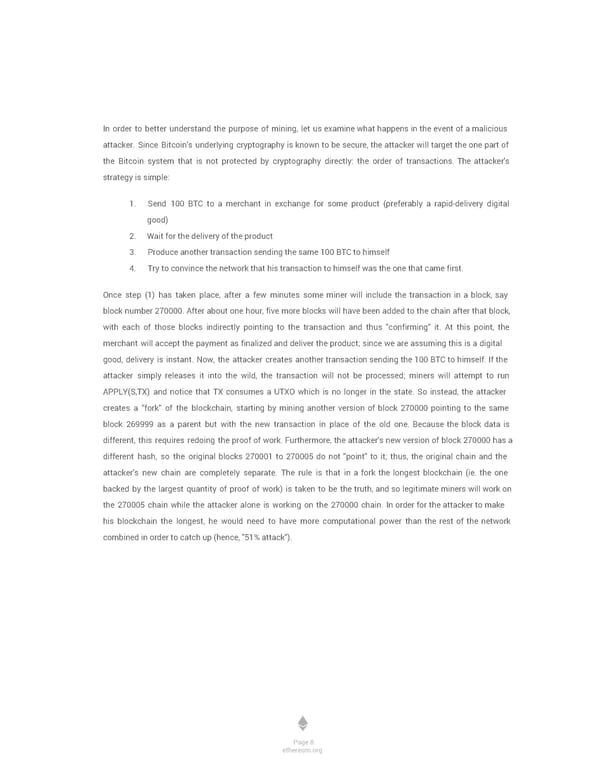In order to better understand the purpose of mining, let us examine what happens in the event of a malicious attacker. Since Bitcoin's underlying cryptography is known to be secure, the attacker will target the one part of the Bitcoin system that is not protected by cryptography directly: the order of transactions. The attacker's strategy is simple: 1. Send 100 BTC to a merchant in exchange for some product (preferably a rapid-delivery digital good) 2. Wait for the delivery of the product 3. Produce another transaction sending the same 100 BTC to himself 4. Try to convince the network that his transaction to himself was the one that came first. Once step (1) has taken place, after a few minutes some miner will include the transaction in a block, say block number 270000. After about one hour, five more blocks will have been added to the chain after that block, with each of those blocks indirectly pointing to the transaction and thus "confirming" it. At this point, the merchant will accept the payment as finalized and deliver the product; since we are assuming this is a digital good, delivery is instant. Now, the attacker creates another transaction sending the 100 BTC to himself. If the attacker simply releases it into the wild, the transaction will not be processed; miners will attempt to run APPLY(S,TX) and notice that TX consumes a UTXO which is no longer in the state. So instead, the attacker creates a "fork" of the blockchain, starting by mining another version of block 270000 pointing to the same block 269999 as a parent but with the new transaction in place of the old one. Because the block data is different, this requires redoing the proof of work. Furthermore, the attacker's new version of block 270000 has a different hash, so the original blocks 270001 to 270005 do not "point" to it; thus, the original chain and the attacker's new chain are completely separate. The rule is that in a fork the longest blockchain (ie. the one backed by the largest quantity of proof of work) is taken to be the truth, and so legitimate miners will work on the 270005 chain while the attacker alone is working on the 270000 chain. In order for the attacker to make his blockchain the longest, he would need to have more computational power than the rest of the network combined in order to catch up (hence, "51% attack"). Page 8 ethereum.org
 Ethereum White Paper by Vitalik Buterin Page 8 Page 10
Ethereum White Paper by Vitalik Buterin Page 8 Page 10